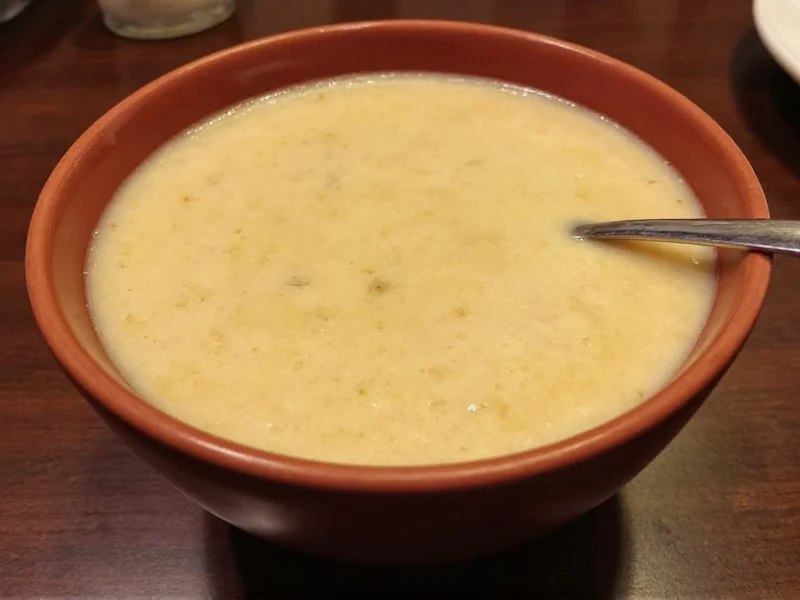Cream soups represent one of the five mother sauces in classic French cuisine, specifically falling under the "velouté" category when enriched with dairy. This culinary tradition dates back to 17th century France, where chefs in the court of Louis XIV developed techniques for creating smooth, elegant soups suitable for refined dining. The term "cream soup" doesn't necessarily mean every variety contains heavy cream—many traditional preparations use milk, half-and-half, or even dairy alternatives while maintaining the essential smooth texture.
Defining Characteristics of Cream Soup
Three elements distinguish true cream soups from other creamy preparations:
- Texture uniformity—absolutely no visible particles, achieved through fine pureeing and often double-straining
- Dairy integration—milk, cream, or butter incorporated after pureeing to prevent curdling
- Flavor balance—the primary ingredient's taste remains prominent despite the richness
Many home cooks confuse cream soups with chowders or bisques. While bisques share the smooth texture, they traditionally contain shellfish and are thickened with rice. Chowders maintain visible chunks and often use potatoes for thickness. Understanding these distinctions helps when following authentic cream soup preparation techniques.
Classic Cream Soup Varieties
Culinary tradition recognizes several foundational cream soup types, each defined by its primary ingredient:
| Cream Soup Variety | Primary Ingredient | Traditional Accompaniments |
|---|---|---|
| Cream of Mushroom | Wild or cultivated mushrooms | Chives, sherry, crusty bread |
| Cream of Tomato | Ripe tomatoes | Basil, croutons, Parmesan |
| Cream of Broccoli | Fresh broccoli florets | Cheddar cheese, lemon zest |
| Cream of Asparagus | Young asparagus spears | Hard-boiled eggs, tarragon |
| Cream of Chicken | Poached chicken meat | Herbs, rice, roasted vegetables |
Essential Preparation Techniques
Creating authentic cream soup requires specific methodology to achieve the proper texture and flavor balance. The classic approach involves three distinct phases:
1. Base Preparation
Chefs begin by cooking the primary ingredient (vegetables, poultry, or seafood) in a flavorful liquid until completely tender. This stage develops the foundational flavor without introducing dairy, which could curdle during prolonged cooking. Many professional kitchens use a mirepoix (diced carrots, celery, and onions) as an aromatic base.
2. Pureeing and Straining
After cooking, the mixture undergoes thorough pureeing using high-powered blenders or food processors. For restaurant-quality results, chefs then push the puree through a fine-mesh sieve to eliminate any remaining fibers or particles—a step many home cooks skip when learning how to make smooth cream soup. This double-processing ensures the signature velvety texture.
3. Dairy Integration
The critical final step involves tempering dairy ingredients to prevent curdling. Chefs gradually incorporate warm dairy into the cooled puree while constantly stirring. The mixture then gently reheats to serving temperature without boiling, which would cause separation. Understanding cream soup preparation techniques prevents common texture problems that frustrate novice cooks.
Avoiding Common Cream Soup Mistakes
Even experienced cooks encounter issues when preparing cream soups. These frequent problems and their solutions address what many search when researching cream soup texture problems:
- Curdling—occurs when dairy hits temperatures above 180°F (82°C). Solution: Always cool puree slightly before adding dairy, and never boil after dairy addition
- Grainy texture—results from insufficient straining. Solution: Use a chinois or fine-mesh sieve after pureeing
- Weak flavor—happens when primary ingredients lack concentration. Solution: Reduce cooking liquid before pureeing to intensify taste
- Separation—occurs with improper emulsification. Solution: Add a small amount of roux or cornstarch slurry before dairy introduction
Serving Traditions and Pairings
Cream soups serve as either starters or light main courses depending on their richness and accompaniments. Traditional service guidelines include:
- Temperature—serve between 160-170°F (71-77°C); never boiling hot which diminishes flavor perception
- Portion size—6-8 ounces as an appetizer, 12-16 ounces as a main course
- Garnishes—use complementary elements that add texture contrast without disrupting smoothness
- Pairings—light cream soups pair with crisp white wines, while richer varieties match well with oaked Chardonnay
When considering cream soup serving temperature, remember that overheating not only affects flavor but can cause dairy separation. The ideal temperature allows all flavor compounds to be fully perceptible without scalding the palate.
Modern Variations and Dietary Adaptations
Contemporary chefs have developed numerous adaptations that maintain cream soup's essential characteristics while accommodating dietary needs. Successful dairy alternatives for cream soup include:
- Cashew cream for vegan preparations
- Coconut milk in tropical-inspired varieties
- Blended white beans for protein-rich versions
- Roasted cauliflower puree as a low-carb option
These substitutions require technique adjustments—cashew cream needs extended soaking, while cauliflower benefits from roasting before pureeing. Understanding what makes cream soup different from regular soup helps adapt recipes while preserving the essential smooth texture and rich mouthfeel.











 浙公网安备
33010002000092号
浙公网安备
33010002000092号 浙B2-20120091-4
浙B2-20120091-4